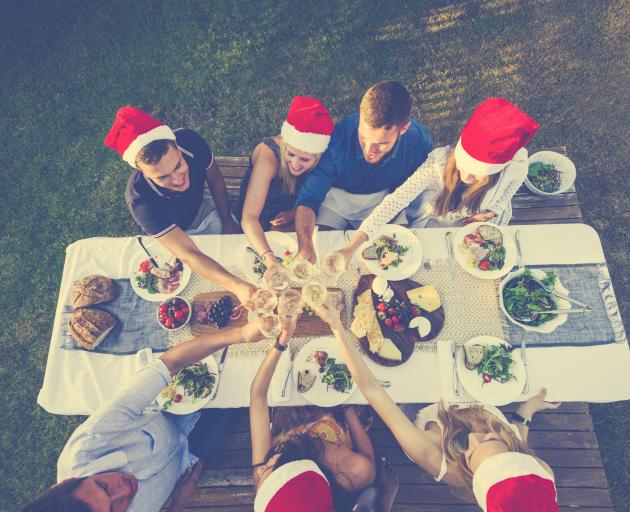
Dr Kirsty Fairbairn discusses the risky diet of the festive season.
It’s that time of year again, when minds turn from work to weather, from schedules to socialising, from frantic to family.

It’s a time when many of us will reflect on the year just ended, and set expectations for the coming 12 months.
Christmas is a great time for socialising with friends and family, and much of that centres around food.
We are lucky in New Zealand that we have an abundance of summer’s fresh produce to indulge in: cherries, stonefruit, new potatoes, peas and salad vegetables. Our Christmas Day food is so different from that in the northern hemisphere, and it feels fresher, maybe because we are often outside cooking on the BBQ or down at the lake or beach.
Lately I’ve been looking at beverage alternatives for the festive season.
There seems to be two types of beverages around us. One is high calorie and nutrient poor, and has a robust marketing budget to drive summer sales. I’ll call this type commercial. These drinks are formulated to appeal to our demand for taste (i.e. sugar) and frequently are associated with a well-marketed lifestyle or emotion so that you choose their product over a competitors.
The other type is low kilojoule (calorie), and are sometimes nutrient rich. These may have a small, or possibly nonexistent, marketing budget. If they are sold in your supermarket they could be on a small section of shelving either way above eye level, or way below (or in the tea section). This type I’ll call energetic.
While they have less energy in the calorie sense of the word, you’ll feel more energtic for consuming them, and they are not the energy drinks that use funky youth and adventure-sport marketing, loaded with caffeine and either sugar or sweeteners (energy for five minutes perhaps).
In fact, because this term energy can get confusing, I am going to refer to kilojoules when I refer to food energy here. Kilojoules is the term that we use for the energy that you eat in your diet. Americans (on the imperial system) use the term calories. There are 4.12 kilojoules in one calorie (fact of the day). If I refer to kilojoules as the food energy, I can reserve the term energy for how energetic you feel. It should be a positive word!
At this time of year, it is easy to get into the habit of drinking more of those high-calorie drinks (and more alcohol) than usual. In the accompanying table I have put together a list of beverages, their energy content and their cost. I found this exercise really interesting.
Soda water and sparkling water have piqued my interest, and I’ve also been looking for recipe ideas to jazz these up a bit. Some ideas include serving your water with ginger, mint, lemon or herbal/fruit teabags. A good project to do with the children one day can be to chop up pieces of summer fruit or mint and and pop them into ice cube trays to freeze.
As the table shows, we can quickly add a lot of extra kilojoules to our diet with certain drinks. This is due partly to the kilojoule content of the drink, and partly due to our drinking habits when consuming them. Some beverages contain alcohol (which provides 29 kilojoules per gram) and sugar (providing 17 kilojoules per gram).
A low-sugar alcoholic beverage certainly does not make it kilojoule-free and the higher the percentage of alcohol in it, the more grams of alcohol (and thus kilojoules) it will contain.
Then you may or may not choose to add more kilojoules via mixers. Thus, the energy content of these drinks can add up quickly!In my experience, drinking less alcohol has been a very effective weight-loss strategy for my clients, and it might be something you want to consider this summer.
For example, one dozen low-alcohol lagers contributes 1680kJ. That is almost a meal’s worth of kilojoules, but lower in nutrients. That is also just over eight standard drinks of alcohol. For optimal long-term health, the Health Promotion Agency recommends less than three standard drinks a day for men, and less than two standard drinks for women, with two alcohol-free days a week.
A dozen normal strength lagers adds up to 2700kJ (that’s a lunch or light dinner kilojoule equivalent right there). Definitely not a dinner’s worth of nutrients though.
Six 200ml glasses of red or white wine adds up to 3720kJ, the kilojoule content of your breakfast and lunch combined! Would you eat two breakfasts and two lunches in a day and expect to maintain a healthy body weight? Unless perhaps you are in training for the Wanaka Ironman!
While a trim cappucino has a similar kilojoule content as regular strength beer, not many of us would down six coffees in a row.
So this social season, help yourself and your friends get the most out of summer and boost everyone’s energy levels. Sometimes we can feel everyone expects to eat and drink this way over Christmas, but you may be surprised.
- Dr Kirsty Fairbairn is a health, wellness and sports dietitian at Invigorate Nutrition (www.invigoratenutrition.com), based at Eclipse Health, Wellness and Performance, Hanover St, Dunedin.











